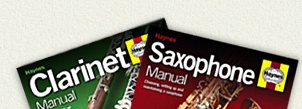

Testing the actionIf you've read the page in the Glossary about the action then you'll know just what a complex thing it is. You'll also be aware that any problems associated with the action tend to be somewhat expensive to fix.But perhaps you have a brand new instrument, and so you naturally assume that there can't possibly be any problems with the action - or perhaps your instrument isn't so new, but because all the keys seem to go up and down it's probably a fair bet that all is well. Unfortunately, neither scenario is any guarantee that all is well with the action. Most woodwind instruments will exhibit some signs of wear in the action after a few years of use - and it's entirely possible to find brand new instruments that show signs of wear in the action...though this will be down to poor manufacturing rather than proper wear and tear. In some cases, particularly with cheap instruments, it can be quite severe. It's relatively easy to check for wear or defects in the action - all you really need is a finger and a thumb, and a basic understanding of how the mechanism works. I can (hopefully) provide the latter, and you might find it useful to have your instrument handy as you read through this article.Study the picture below, which shows the two common types of pivot/key combinations; a rod or hinge screw mounted key and a point or pivot screw mounted key. Note that in the case of the rod screw, it passes through the key via its barrel, and in the case of the point screw the key is mounted on (typically) a pair of screws at each end of the key barrel.
The two pivot types wear in slightly different ways. Rod screws may
rub along their entire length, thus wearing the entire barrel of the key.
Point screws only contact on the ends of the barrel, so the wear is confined
here (much cheaper to sort out too).
The diagram above shows the three types of wear commonly found on keys that are pivoted on rod screws. Now, pinch the key as near to its centre on the key barrel
as you can - and try to move it from side to side...left to right, as
it were...
Flutes are a slightly different matter - some of the keys are joined
together to form what's known as a 'compound key'. This means that two
or more keys are pivoted on a rod...which is then pivoted itself on points.
Double trouble! Let's just scare the sax players a little bit more - try the low B/Bb key, don't forget to wobble the keys at both ends. By doing these simple tests all over your instrument you'll gain a rough
idea as to the (excuse the pun) state of play. This is just a guide though,
you might perhaps feel that a little wobble is insignificant when in fact
it could be quite a problem. And that problem is that whenever a key is
pressed down it tries to take the path of least resistance. With a well
maintained action the keys have no choice but to go where they're meant
to go...straight down onto the tone hole. Chuck in a bit of wear on the
pivots and a key will try to take up this free play as soon as it can.
This might be at the beginning of its stroke or at the end. All is not lost - this free play can be removed (though with varying
degrees of difficulty). Rod screw keys can have the key barrels 'swedged'
(pronounced swayged, as in wages). This is done using a special tool that
compresses the key barrel - and let me tell you, it can be hard going. There are still other methods. Some point screws have no shoulder (see Point Screws) and need only be screwed in further. Some rod screw keys have little or no key barrel to compress, so they may require filling in and re-boring, or an oversized rod screw (always a pain, as you have to do the pillars too - and any other keys that sit on the same pivot). Some repairers take up end to end play with little teeny washers. This works a treat...for longitudinal play, but the tragedy is that this kind of play is nowhere near as bad as lateral play, which washers do b****r all to correct. They also look rather ugly. I should imagine that some of you are wondering why you can't just take a screwdriver to your instrument and tighten all the point screws up yourself. Well, you can - but depending on the type of screw (shouldered or cylindrical) you'll either make no difference at all and possibly bust the head of the screw finding out, or you'll lock the action up solid. With plastic bodied clarinets in particular you might find that all goes swimmingly well - but when you next take the instrument out of the case the action has locked solid because the body has cooled and contracted. For more information on the action, take a look at Matt
Stohrer's excellent article on key fitting, which discusses
in detail the techniques used to correct free play in the action. |
If you've enjoyed this article or found it useful and would
like to contribute
towards the cost of creating this independent content, please use the button
below.

 Now
let's have a go at the point screw keys.
Now
let's have a go at the point screw keys.